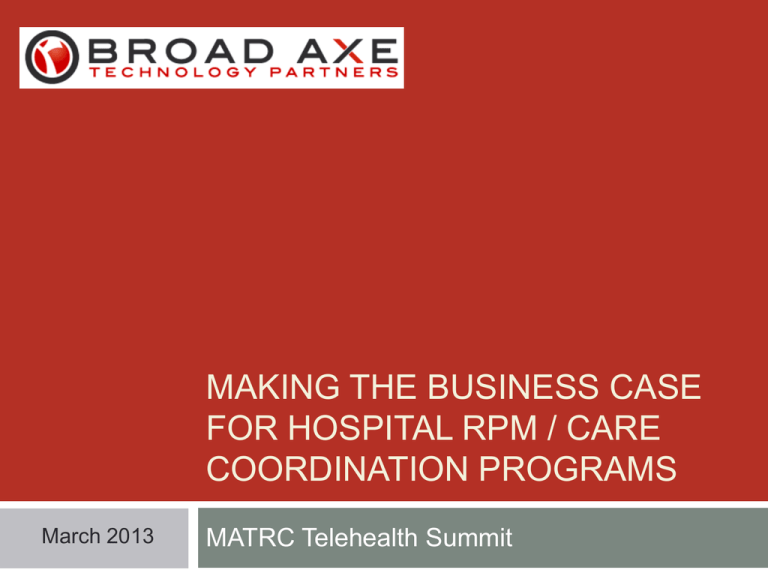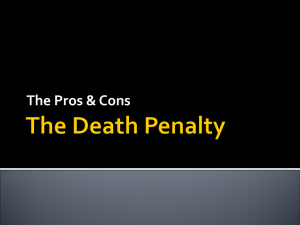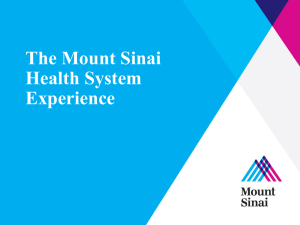Kirby Farrell
advertisement

MAKING THE BUSINESS CASE FOR HOSPITAL RPM / CARE COORDINATION PROGRAMS March 2013 MATRC Telehealth Summit Agenda 1 Who We Are/Our Approach Remote Patient Monitoring for Care Coordination: Value Drivers Readmissions and the Value of Avoided Penalties Costing an RPM/CC Solution Making the Business Case Who We Are 2 Virginia-based Telehealth Services firm providing Care Coordination Services via Remote Patient Monitoring Founders are serial entrepreneurs with significant experience in: Lower patient readmissions Improve outcomes for key patient populations Position health systems strategically for new environments (ACO, shared risk, etc) Enhance and better leverage data analytics Design and operation of secure networks and operation centers for health care and defense Public/Private Partnerships Health care market research and analytics Key Clients Commonwealth of Virginia University of Virginia University of Virginia Medical Center New College Institute – Southside Telehealth Training Academy and Resource Center (STAR) Virginia Tobacco Commission – Special Projects Our Approach to Hospital-Based RPM 3 Patient Risk Stratification and Selection Care Coordination Center Patient targeting/best practices Home Health Nurse Case Manager Regular reporting Key Transition Activities: • Hub/device home install • Patient training • Med reconciliation/PCP appt • Connection established with RN monitor Alert intervention Over time: Highest-Risk Frequent Readmits Provider Coordination via Clinical Review Software and Reporting Primary Care Physician Biometric/symptom data Heart Failure AMI Pneumonia COPD CABG PTCA Other vascular Transition to Home: “Activation” and Daily Monitoring Coordination w/ Hospital Discharge Hospitalbased Clinic Outcomes Reporting: • Readmissions • Population health • Costs • Satisfaction Evidence for RPM Efficacy 4 Commonwealth Fund RPM Case Studies: January 2013 Centura Health (Colorado): Centura Health at Home program reduced 30day readmission rates for patients with target conditions CHF, COPD, and diabetes by 62% in 2010/11 one-year pilot Partners HealthCare (Boston): Connected Cardiac Care Program has consistently reduced CHF-related readmission rates by ~50% and nonrelated readmission rates by 44% 200 patients enrolled, generating cost savings of $1,000-1,500 total cost per patient 1,200 patients enrolled since 2006, generating cost savings of more than $10m (Chronic Disease Management) Veterans Health Administration: Care Coordination/Home Telehealth program decreased total healthcare resource utilization (hospital days of stay) by ~25% for both single/multiple diagnoses across 8 target conditions between 2004-07 Currently more than 70,000 enrollees Source: Commonwealth Fund publications 1654-1657, Jan 2013 Why RPM for Hospitals? 5 Value Drivers Financial: Lower patient readmissions and avoid penalties (Shortterm ROI) Quality: Improve health outcomes and satisfaction for key patient populations Efficiency: Enhance and better leverage information and analytics between providers to provide more effective care Strategic: Position health systems for new environments (ACO, shared risk, etc) Hospital Readmissions Context 6 CMS Hospital Readmission Reduction Program (HRRP) penalties effective as of October 1, 2012 CMS penalties expected to grow meaningfully 30-day readmission measures for three key conditions (AMI, HF, Pneumonia) ~70% of U.S. hospitals penalized Average FY13 penalty: 0.3% of aggregate inpatient payments New conditions added Penalty caps increased Higher hurdles for “expected” readmission rates Other payers expected to follow CMS in assessing penalties Readmissions Penalties in MATRC Region 7 3 MATRC states and D.C. in highest penalty quartile nationally for CMS 30day readmissions, and all except Delaware in the top half FY13 HRRP Penalty Percentage Map First Quartile (highest penalty rates) Second Quartile Third Quartile Fourth Quartile (lowest penalty rates) Note: Maryland does not participate in HRRP program due to CMS allowance of its state-based program Source: CMS; Kaiser Health News Key Insights for Penalty Estimation 8 Future penalties are being “accrued” based on recent/current lack of action on readmission reduction No action now = a deeper hole The penalty “stick” is roughly 5x greater than than Medicare payments for the readmissions themselves Excess readmissions ratio (actual rate ÷ expected rate) drives penalty CMS-measured 30-day readmission rates often higher than hospital-measured “raw” rates Due to “all cause” readmission methodology and readmits to other acute care hospitals Excess readmission rates characterized as “No Different from the U.S. National Rate” per Hospital Compare (confidence intervals) are still penalized CMS Penalty Formulas 9 Estimated penalties depend on: Excessive readmissions in each key condition How “costly” the condition is CMS Medicare Penalty: Calculation Methodology 1. Excessive payments for each condition are calculated as: Hospital’s Actual Rate 1 X Hospital’s Expected Rate 2. Discharges in each condition X Base DRG payment for each condition Calculate the sum of excessive payments for all conditions (currently: AMI, HF, Pneumonia) Sum of excessive payments 3. Excess readmissions penalty rate Aggregate payments for all discharges 4. Penalty rates imposed for each year: • FY13: the lower of 1% or the penalty rate • FY14: the lower of 2% or the penalty rate • FY15: the lower of 3% or the penalty rate Notes: • Actual Rate calculated over trailing 3-year period (currently FY2009-11) • Actual Rates are “risk-adjusted” • Expected Rate = U.S. national rate over same period Projected CMS Penalty Calculation: Illustrative Hospital Case (Current) 10 Hospital Facts: Medium-sized MATRC-region hospital with ~350 beds Higher 30-day readmit rate than National Rate in all three conditions; AMI a particular problem Excess Readmission Ratio Calculations Hospital Compare Expected 30-day Key 30-day Readmit Rate Condition Readmit Rate (=US Nat'l Rate) AMI Heart Failure Pneumonia 22.0% 24.8% 19.5% 19.7% 24.7% 18.5% Excess Excess Readmission Readmission "Stick Percentage RATIO Factor" 2.3% 0.1% 1.0% 11.7% 0.4% 5.4% 5.1 4.0 5.4 Projected Penalty Calculations Excess Key Readmission Condition RATIO AMI Heart Failure Pneumonia 11.7% 0.4% 5.4% Total DRG cost per condition $1,299,887 $1,844,822 $541,357 Penalty Estimate $151,763 $7,469 $29,263 $188,495 Annual Discharges ÷ 97 209 97 403 Average Penalty per Patient: $468 Projected CMS Penalty Calculation: 10% Decline in “Expected Rate” 11 Key Assumptions: National Average rate improves and/or CMS imposes more stringent “expected” rate hurdles so that expected rates decline by 10% Hospital does not take sufficient action to reduce readmissions in key conditions Excess Readmission Ratio Calculations Hospital Compare NEW Key 30-day Expected 30-day Condition Readmit Rate Readmit Rate AMI Heart Failure Pneumonia 22.0% 24.8% 19.5% 17.7% 22.2% 16.7% Excess Excess Readmission Readmission "Stick Percentage RATIO Factor" 4.3% 2.6% 2.9% 24.1% 11.6% 17.1% 5.6 4.5 6.0 Projected Penalty Calculations Excess Key Readmission Condition RATIO AMI Heart Failure Pneumonia 24.1% 11.6% 17.1% Total DRG cost per condition $1,299,887 $1,844,822 $541,357 Penalty Estimate $313,058 $213,279 $92,665 $619,002 Annual Discharges ÷ 97 209 97 403 Average Penalty per Patient: $1,536 Value of Penalty Avoidance Often Underestimated 12 The “Accrual Effect”: penalties being paid now are lower than penalties actually being accrued, if no improvement is made Penalty estimates with Hospital Compare based on 3-year look back, so penalties paid now based on actions not taken in FY09-11 What hospitals do now has a delayed impact on penalty avoidance but is critical to avoid “deeper hole” “Expected” Readmissions rate will continue to fall As other hospitals improve, reducing raw national rate If CMS unilaterally sets more aggressive target rates New conditions will be added Four new conditions (COPD, PTCA, CABG, other vascular) included in FY15 penalty Assume same 3-year look-back methodology Penalty caps will be increased each year 1% currently 2% in FY14 3% in FY15 “Costing” an RPM/CC Solution: Components 13 Staff-related monitoring costs: Patient : staff monitor ratios – from 75:1 to 150:1 depending on type of solution, 30-day readmissions vs. chronic disease management Use of RNs vs. health coaches/social workers Hours of center operation Staff-related field costs: Installation/refurbishment Depends on population targeted – 30-day readmits vs. chronic disease management (i.e .shorter monitoring periods mean higher amount of patient “churn”) Depends on region covered (i.e. location of monitoring center relative to patients) Technology-related costs: Hardware and software typically bundled, peripherals can vary Leasing more common than owning EMR Integration extra Other costs: Project management Integration with key provider departments (case management, clinical, home health) Costing a Turnkey Solution: Illustrative 14 Primary cost drivers are in centralized monitoring and field support staff Don’t forget PCP and departmental interfaces, as well as program management Technology only 10-15% of total cost bar Estimated cost of $700-$1,100 per patient – some scale required 100% 90% 21% 80% Other 70% Technology 60% Field Staff 50% 11% 20% 40% Clinical Monitoring Staff 30% Program Mgmt and Hospital Interface 30% 20% 10% 18% 0% RPM Cost Components 50% of costs in monitoring/ field staff Making the Business Case: MATRC Hospital Illustrative Case 15 Value of avoided penalties (per patient) > At 10% lower “expected” ~$1,500 30-day readmit rates: At 5% lower “expected” 30-day readmit rates”: ~ $975 Estimated cost of RPM solution (per patient) ~$900 Making the Business Case: Positioned for the Future 16 Quality: Improve health outcomes and satisfaction for key patient populations Efficiency: Enhance and better leverage information and analytics between providers to enhance collaboration and provide more effective care Strategic: Position health systems for emerging environments (ACO, shared risk, etc) 455 Second St SE Charlottesville, VA 22902 Kirby Farrell kfarrell@broadaxepartners.com Andy Archer aarcher@broadaxepartners.com March 2013 MATRC Telehealth Summit









